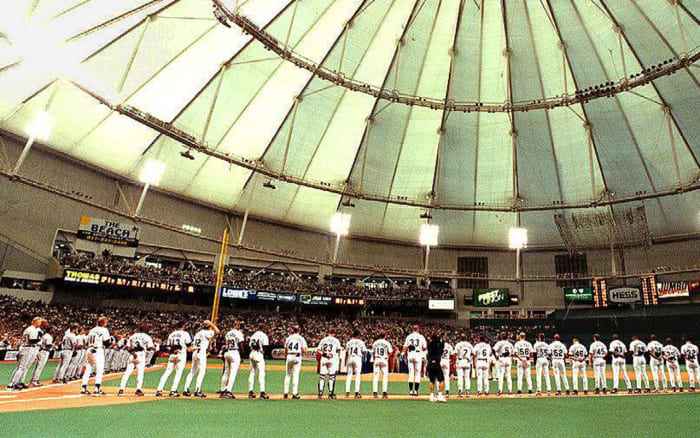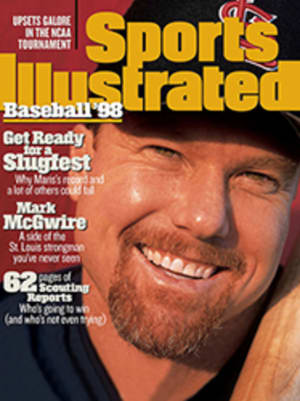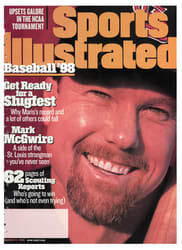1998 Baseball Preview: Tampa Bay Devil Rays
During Spring training Vince Naimoli, managing general partner of the expansion Devil Rays, was haunting the clubhouse like Banquo's ghost. One hot, lazy morning he was doing a walkabout in the cramped clubhouse, rubbing elbows with his Tampa Bay nine while dressed to the nines in a black team jacket and a rep tie with the purplish splotches of the Devil Rays' logo. "Are you a patient man?" he was asked.
"I'm as patient as anyone else," Naimoli replied.
If that anyone is, say, Naimoli's friend George Steinbrenner, then much of general manager Chuck LaMar's good work might be wasted. LaMar, the respected player development man who was spirited from the Braves to build the Devil Rays, has issued a mission statement that can be reduced to, Win some now, win a whole lot more a little later. "We want to be here for a long, long time," LaMar says. "To be a championship organization that has the ability to stay at that level year in and year out. If we start to waver after two or three years, we're in trouble."
LaMar suggests five years is the proper perspective from which to judge an organization, though he concedes a reasonable level of professionalism and victories must come sooner if fans and ownership are to be placated. "If you put a team out there that does not have the earmark of a major league product," he says, "the fans will eat you alive."
The Devil Rays already resemble a big league club--if you get past the uniforms with the customized-van color scheme of black, yellow, purple, turquoise, blue and green that is supposed to represent the shimmering waters (not to mention the sand, sun and lush green landscape) of Tampa Bay but looks more like something Evel Knievel might don before jumping 12 school buses. There are familiar faces at the corners in Tampa residents Wade Boggs and Fred McGriff and some marquee pitchers in lefthander Wilson Alvarez and righthanded closer Roberto Hernandez. In a burst of spring optimism Hernandez suggested the Devil Rays could play better than .500.
"They're not drafting and signing players to be doormats," says Hernandez, who signed a four-year, $22.5 million contract. "You don't hear 'expansion' being used much around this clubhouse." (Indeed, the Devil Rays prefer to call themselves a "first-year team.") A premier, positive-thinking closer might seem extravagant for a team that will be lucky to have one or two save situations a week, but Tampa Bay easily can afford a few luxury items.
The Devil Rays became an instant big-market club after selling 23,000 season tickets--and about 2.3 million tickets overall--before opening the gates. They have leased all 65 luxury suites for five to 10 years, have a lucrative statewide cable TV package, have sold 97% of the signage at the stadium and have peddled so many ads for their game programs that Michener novels look as flimsy as Archie comics by comparison. Their payroll will be a relatively modest $27 million or thereabouts, but revenue could rank them as high as eighth among the 30 teams.
LaMar especially admires the expansion work of the 1977 Blue Jays and the Rays' National League forebears, Colorado and Florida. But unlike the Marlins, who cherry-picked such top pitchers as Kevin Brown and Al Leiter before their deconstruction, Tampa Bay plans to grow some of its own. The gem of the system is at least a year away: righthander Matt White, the Giants' 1996 first-round draft choice who became a free agent on a technicality. The rate of attrition is high and the science of scouting pitchers inexact, but the spiraling cost of free-agent pitching will prompt LaMar to stay in-house as much as possible.
The other, quirkier Devil Rays' philosophical decision was the hiring of a manager with no major league experience. Of the 10 candidates interviewed, only Hal McRae had managed in the bigs. Tampa Bay selected Larry Rothschild, Florida's pitching coach. "We wanted someone capable of managing in the majors right now," LaMar says, "but who would continue to improve and grow into the job as our own organization continues to grow."
Of course, growth takes patience, which, as we know, Naimoli has as much of as anyone. "I hope," the passionate owner says, "the fans' patience coincides with mine."
--M.F.
COLOR PHOTO: CHUCK SOLOMON TAKING CHARGE In a season of endless firsts, catcher John Flaherty auditions for the role of the Devil Rays' first field general.
COLOR PHOTO: TOM DIPACE [Wade Boggs]
BY THE NUMBERS
Expansion Team Statistics (major league only)
COMPOSITE '97 BATTING AVG. .270 STADIUM CAPACITY 45,200 COMPOSITE '97 ERA 4.85 SEASON TICKETS SOLD 23,000 AVG. MLB EXPERIENCE 4.5 years PRICE OF A RED HOT NOT SET YET
OFF-SEASON MOVES
WHAT THEY NEEDED: What didn't they need?
WHAT THEY GOT: Well, lots of players, most of the scrub variety. Wilson Alvarez will be the ace, Roberto Hernandez the closer, pitcher Tony Saunders the future, third baseman Wade Boggs and first baseman Fred McGriff the big names and Quinton McCracken the best name.
WHAT IT ALL MEANS: The Devil Rays' middle relief is very, very bad, and aside from Alvarez and Saunders, the rotation is not a whole lot better. They will probably finish last, but at least they'll do it with a decent infield (Boggs, McGriff, backup first baseman Paul Sorrento and shortstop Kevin Stocker are competent players).
THE X-FACTOR
We've all seen once-great vets use expansion as a life-support system for their wallets (Dale Murphy, Rockies), and it's not pretty. Which doesn't mean Wade Boggs, 39, can't find his lifetime .331 stroke one last time. Platooning for the Yankees in '97, Boggs hit .292, not bad for a guy who was supposed to be washed up. If the future Hall-of-Famer gets 160 hits this season, he'll be 40 short of 3,000 for his career. Those hits won't generate many wins, but they will force the Devil Rays to bring him back so they can cash in on his pursuit of 3,000--which will finally give their fans something worth cheering for.
Projected Roster With 1997 Statistics Manager: Larry Rothschild (first season with Tampa Bay)
BATTING ORDER B/T BA HRs RBIs SBs
CF Quinton McCracken S/R .292 3 36 28 3B Wade Boggs L/R .292 4 28 0 1B Fred McGriff L .277 22 97 5 DH Paul Sorrento L/R .269 31 80 0 LF Mike Kelly R .293 6 19 6 RF Dave Martinez L .286 12 55 12 C John Flaherty R .273 9 46 4 SS Kevin Stocker S/R .266 4 40 11 2B Miguel Cairo* R .279 5 46 40
BENCH
OF Bubba Trammell R .228 4 13 3 OF Rich Butler* L/R .300 24 87 20 IF Aaron Ledesma R .352 2 11 1 C Mike Difelice R .238 4 30 1
STARTERS W L IPS BR ERA
LH Wilson Alvarez** 13 11 6.4 1.30 3.48 LH Tony Saunders 4 6 5.3 1.48 4.61 RH Rolando Arrojo+ 5 6 5.6 1.08 3.43 RH Dennis Springer 9 9 6.5 1.45 5.18 LH Terrell Wade 2 3 4.4 1.86 5.36
RELIEVERS W L IPS BR ERA
RH Roberto Hernandez** 10 3 31 1.31 2.45 RH Esteban Yan* 11 5 2 1.25 3.10 LH Ramon Tatis 1 1 0 1.76 5.34 RH Albie Lopez 3 7 0 1.89 6.93 RH Santos Hernandez++ 1 1 0 1.12 2.30 RH Jose Paniagua* 8 10 0 1.56 4.64
(R) Rookie B/T: Bats/throws IPS: Innings pitched per start BR: Base runners per inning pitched *Triple A stats **Combined AL and NL stats +Class A stats ++Double A stats


